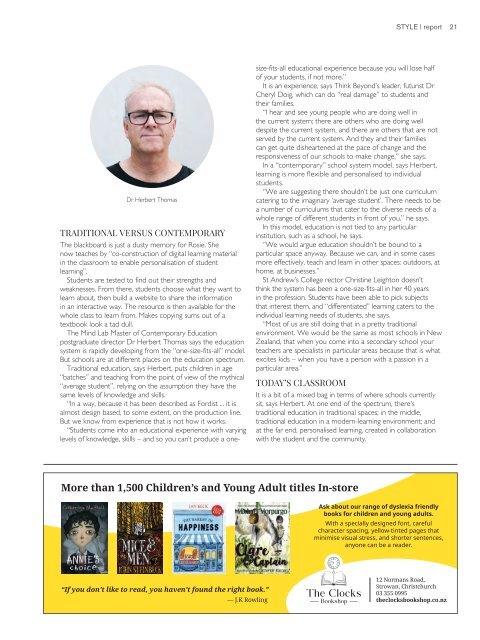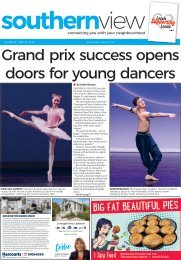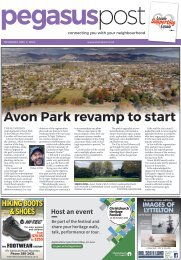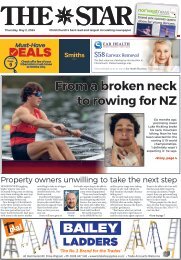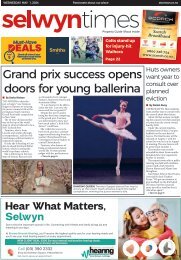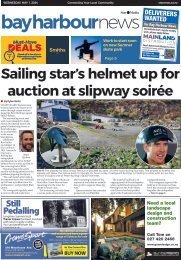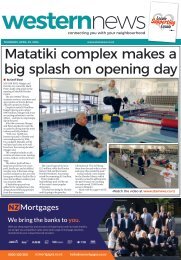You also want an ePaper? Increase the reach of your titles
YUMPU automatically turns print PDFs into web optimized ePapers that Google loves.
STYLE | report 21<br />
Dr Herbert Thomas<br />
TRADITIONAL VERSUS CONTEMPORARY<br />
The blackboard is just a dusty memory for Rosie. She<br />
now teaches by “co-construction of digital learning material<br />
in the classroom to enable personalisation of student<br />
learning”.<br />
Students are tested to find out their strengths and<br />
weaknesses. From there, students choose what they want to<br />
learn about, then build a website to share the information<br />
in an interactive way. The resource is then available for the<br />
whole class to learn from. Makes copying sums out of a<br />
textbook look a tad dull.<br />
The Mind Lab Master of Contemporary Education<br />
postgraduate director Dr Herbert Thomas says the education<br />
system is rapidly developing from the “one-size-fits-all” model.<br />
But schools are at different places on the education spectrum.<br />
Traditional education, says Herbert, puts children in age<br />
“batches” and teaching from the point of view of the mythical<br />
“average student”, relying on the assumption they have the<br />
same levels of knowledge and skills.<br />
“In a way, because it has been described as Fordist ... it is<br />
almost design based, to some extent, on the production line.<br />
But we know from experience that is not how it works.<br />
“Students come into an educational experience with varying<br />
levels of knowledge, skills – and so you can’t produce a onesize-fits-all<br />
educational experience because you will lose half<br />
of your students, if not more.”<br />
It is an experience, says Think Beyond’s leader, futurist Dr<br />
Cheryl Doig, which can do “real damage” to students and<br />
their families.<br />
“I hear and see young people who are doing well in<br />
the current system; there are others who are doing well<br />
despite the current system, and there are others that are not<br />
served by the current system. And they and their families<br />
can get quite disheartened at the pace of change and the<br />
responsiveness of our schools to make change,” she says.<br />
In a “contemporary” school system model, says Herbert,<br />
learning is more flexible and personalised to individual<br />
students.<br />
“We are suggesting there shouldn’t be just one curriculum<br />
catering to the imaginary ‘average student’. There needs to be<br />
a number of curriculums that cater to the diverse needs of a<br />
whole range of different students in front of you,” he says.<br />
In this model, education is not tied to any particular<br />
institution, such as a school, he says.<br />
“We would argue education shouldn’t be bound to a<br />
particular space anyway. Because we can, and in some cases<br />
more effectively, teach and learn in other spaces: outdoors, at<br />
home, at businesses.”<br />
St Andrew’s College rector Christine Leighton doesn’t<br />
think the system has been a one-size-fits-all in her 40 years<br />
in the profession. Students have been able to pick subjects<br />
that interest them, and “differentiated” learning caters to the<br />
individual learning needs of students, she says.<br />
“Most of us are still doing that in a pretty traditional<br />
environment. We would be the same as most schools in New<br />
Zealand, that when you come into a secondary school your<br />
teachers are specialists in particular areas because that is what<br />
excites kids – when you have a person with a passion in a<br />
particular area.”<br />
TODAY’S CLASSROOM<br />
It is a bit of a mixed bag in terms of where schools currently<br />
sit, says Herbert. At one end of the spectrum, there’s<br />
traditional education in traditional spaces; in the middle,<br />
traditional education in a modern-learning environment; and<br />
at the far end, personalised learning, created in collaboration<br />
with the student and the community.<br />
More than 1,500 Children’s and Young Adult titles In-store<br />
Ask about our range of dyslexia friendly<br />
books for children and young adults.<br />
With a specially designed font, careful<br />
character spacing, yellow-tinted pages that<br />
minimise visual stress, and shorter sentences,<br />
anyone can be a reader.<br />
“If you don’t like to read, you haven’t found the right book.”<br />
― J.K Rowling<br />
12 Normans Road,<br />
Strowan, Christchurch<br />
03 355 0995<br />
theclocksbookshop.co.nz


